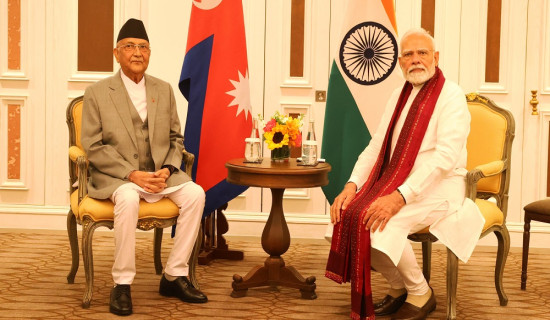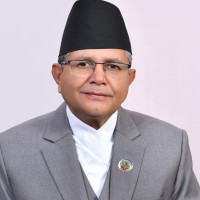- Saturday, 5 April 2025
Converging Interest Helps Find Global Peace
The world is changing deeply with the innovation of new technologies and economy and growing geopolitical shifts. The industrial civilisation that shaped the rationality of institutions and political culture is losing steam. Many nations are psychologically less prepared to adapt to these changes brought about by modern communication, transactions and transportation. Scores of problems such as management of space, cyber security, pandemics and climate change require converging policies and cooperative solutions. To make the world safe for present and future generations entails collective wisdom of world leaders. The geopolitical context shaped by selfish genes, national interest and bargaining strategies misfit with the protection and promotion of global commons and the creation of global governance. The historical norms that governed international relations, international laws and institutions require revisiting. So does the requirement in lifting the standards of living of people.
The shifting geopolitical trends have entailed the three superpowers - the USA, Russia and China - and other powers of various scales as to how to navigate this change, build common ground for conflict resolution and create sustainable order and peace. The converging interests between the USA and Russia to prevent the possibility of World War III are linked to the resolution of the Ukraine war and forging of broad ties. Russian and the American readiness to limit nuclear proliferation and divert the economic surplus to productive sectors, innovation and trade may generate peace dividends. But the US divorce from the European nations, Canada, Mexico and China has spurred sharp divergence. The US differs with the whole world on its commitment to the liberal trade order defined by WTO, post-war consensus on the UN and its specialised agencies for global security, peace and prosperity, financial architecture of the World Bank and IMF, the security order created by NATO for the collective defense of Atlantic nations and democratic affinity.
Security alliances
For the security of Pacific bilateral security alliances with Japan, South Korea, the Philippines and QUAD are created to reduce what the US calls the growing heft of Chinese power and influence. The US-China ties have moved from cooperation to competition as the former deems it a strategic competitor on security, economy and cutting edge technologies. China has a deep seated impulse to rejuvenate its glory aiming to avert humiliation again. The US and China have converging interests on global climate, terrorism, pandemics, nuclear non-proliferation and peace entailing to assume global responsibilities.
US President Donald J Trump, has stated that India and the US must remain united against the “threat of China, radical terrorism and global instability.” He favoured “a strong defense partnership.” He is reconsidering the imposition of reciprocal tariffs on India as it has declined to buy oil from Venezuela for reasons of US sanction and seeking to accommodate American concerns. But the Indian faith in “democratic alliance” may face divergence with the transactional approach of the US. Trump is insisting India to buy its arms which puts it in a dilemma as Russia has offered it joint production of SU 57 fighters. US Defense Secretary Pete Hegseth while visiting to the Philippines and Japan restated the threat from China to the busy waters of South China sea, strengthened deterrence, renewed defense commitment and promised to send more war fighting troops to Japan to counter China which the latter deems predatory. China is the biggest producer and supplier of rare earth minerals and a leader of modern technologies.
India’s perception of the Trump administration’s policies has spurred India-China convergence in certain areas. Both are demographic giants. They control 34 per cent of the world's population and around half of global economic growth. Both are catching up with the West and shaping the world economy. US Vice-President J. D. Vance fears the rise of India and China and their competition with their Western counterparts in manufacturing sectors. Their cheap raw materials, labour and technology are vital to beef up production and gain leverage in value chains. India, however, fears the converging interests of China, Pakistan, Bangladesh, Sri Lanka and Myanmar on Belt and Road Initiative (BRI), the modernisation of their ports and strategic cooperation.
The USA is arming its pacific allies such as Japan, South Korea, Australia, the Philippines and Taiwan. It is also strengthening its position in many littoral and island states. The U.S. Secretary of State Marco Rubio visited the Caribbean nations -- Jamaica, Guyana, Suriname, Central America and the Dominican Republic - to secure American security while seven American B 52 bombers are maneuvering in Diego Garcia, the joint naval military base of the UK and the USA in the Indian Ocean focusing on Iran. During his visit to Greenland US Vice-President J. D. Vance said Russia, China and other nations are taking strong interests in the Arctic passage, naval routes and minerals of this area where America cannot fall behind. He also blamed Denmark for under-investing in Greenland. The US wants to annex this land which is under Denmark’s jurisdiction but seeking independence while the EU is committed to protect it. The trans-Atlantic rift may provide China and India an opportunity to strengthen ties with Europe, Mexico and Canada battered by their affinity to Russia.
The cooperation among China, Russia and the USA can shape the global order. China, Russia and India and others have also established the Shanghai Cooperation Organisation for security. As an alternative to the World Bank and IMF, it helped the creation of BRICS Bank and Asia Infrastructure Development Bank. These alternative economic arrangements are set up to forward new payment systems in local currencies and overcome the fear of economic sanctions while investing in infrastructure development. Russia, China, Pakistan, Iran and Turkey have converging interests to control terrorist groups in Afghanistan, stabilise volatile politics of West Asia and increase investments in economic development. The US is embroiled in conflicts in Lebanon, Syria, Iraq, Sudan, Somalia, Yemen and Iran and many armed groups fighting for an independent Palestine state against the vision of greater Israel and larger American strategic presence through the expansion of its military. Emboldened by its strategic partnership with Russia and China, Iran has ignored the American threat to bomb it if it does not agree on a nuclear deal.
The Global South has opted for multi-alignment. India, Indonesia, Malaysia, Turkey, United Arab Emirates, Saudi Arabia, Brazil, etc. do not have any interest to take any side but to diversify relations with all poles of power. Some of them have supported Ukraine’s sovereignty but also bought Russian oil, gas and arms. India, Saudi Arabia, Turkey and South Africa had tried to engage in peace negotiation on the Ukraine war. But a lack of leverage defied their diplomatic efficacy. Buoyant over its success in resetting diplomatic ties between Iran and Saudi Arabia, China too tried to engage in the peace process in Ukraine but without any success. Europe, the US and Russia have greater stake in Ukraine. The US wants all critical resources of Ukraine in exchange for peace but it supports Russia’s territorial control and its demand for Ukrainian neutrality which the latter opposes. President Trump is unhappy over Ukraine’s interest to renegotiate its minerals deal and join NATO.
The Russia-Ukraine ceasefire of March 28 ensuring the safe navigation of commercial vessels in the Black sea stalled as Russian demanded first the restoration of the SWIFT Banking system. The Paris summit of EU members decided to impose more sanctions against Russia while more missile, economic and strategic support to Ukraine. But their approach to directly deploy forces in Ukraine failed to muster consensus. Germany preferred diplomatic negotiation. Lack of common ground among European nations, Russia and Ukraine has turned the war of attrition prolong. The US strategy to shift NATO’s defense burden to European nations and imposition of tariffs on them forced them to impose counter measures and boycott the products including electric cars. The labour culture of Europe favours collective bargaining which is opposed by the US companies.
Similarly, many European nations such as France, Finland, Denmark, Germany, even Canada advised their citizens not to travel to the US for fear of repatriation. It may affect America’s tourism. They have also advised their consumers to boycott American products affecting its trade volume. Speaking at the Royal Danish Military Academy President of the European Union Ursula von der Leyen said, “If Europe wants to avoid war, it must be ready for war.” She has outlined the “Readiness 2030 Roadmap” with increased defense spending, joint procurement initiatives and strengthened support for Ukraine’s sovereignty and territorial integrity. To ensure sustainable security and welfare of its citizens, the European vision has outlined measures to better anticipate, prevent and respond to a range of risks and threats, including cyber-attacks, sabotage and disinformation campaigns and the impact of climate change.
Shuttle diplomacy
Russia wants an interim government in Ukraine with UN support while the American shuttle diplomacy is seeking to compel both sides to agree to a ceasefire before a peace deal. The USA is obsessed with its own border protection, immigration control, national security, dollar banking system and technological prowess. The rise of inflation and debt and trade deficits, the clout of the deep state, alienation of allies and declining image plague it. China’s rise can be attributed to its internal reforms, innovation, technological development, political stability, multilateralism, globaliation, connectivity and cooperation based on win-win outcome and drawing the converging policies of all nations to its initiatives.
To prevent pushback, China has crafted preemptive policies by increasing ties with Asian, African, Latin American and European nations. The US, by contrast, is alienating neighbours, allies and trade partners and resorting to unilateralism and sphere of influence. The costs of tariff walls are mutually hurting adding to global economic woes. There are also converging interests between China, India, EU, Russia and the USA for global stability and peace. The statespersons of the world must search for converging interests and apply reasons, insights and institutions for the cooperative solutions of global problems.
(Former Reader at the Department of Political Science, TU, Dahal writes on political and social issues.)







-square-thumb.jpg)









